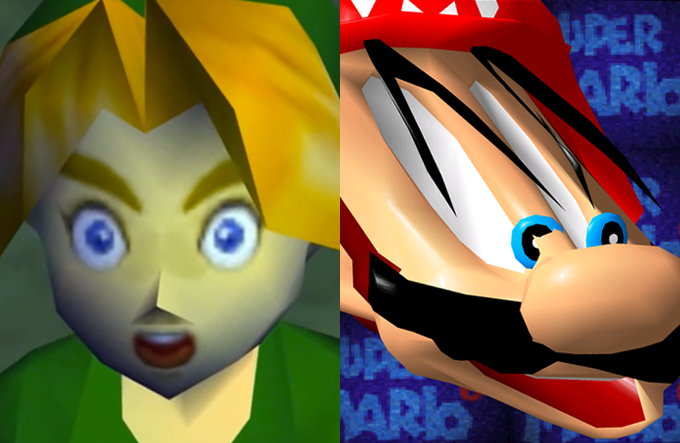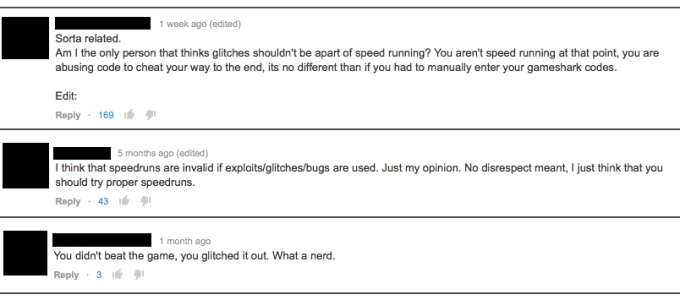Video games are an entirely unique form of entertainment compared to their (somewhat misguided) aspired peers film and television in that their content unveils exclusively at the behest of the player’s level of interaction and skill with the game itself. I.e. the only way to experience the next level is to complete the current one. Even sandbox games are tied (to some degree) to an unalterable linear sequence of events, the bare minimum being that a game has to be started in order to be finished. This may seem self explanatory but it is a novelty completely absent from other forms of media. A book can be read from back to front if the reader so desired, a DVD fast forwarded, a TV show flipped between other channels. There is no doing this with video games. By their very nature, the only way to reach the end is for the player to start from the beginning. Inputs, reactions, more inputs.
With this in mind, it seems inevitable that groups have emerged dedicated to completing games as fast as humanly possible, testing and showcasing their reflexes, knowledge and all round speed. Speedrunning is a form of video game interaction with self-imposed conditions and goals, cutting down how much of the game is actually played to extreme degrees in order to achieve the fastest play time possible. While the overall objective of start-to-finish is still present, the content of the game is whittled away as bugs and gaps in code, gone unnoticed or ignored during the game’s development, are found, researched and exploited by players to skip over portions of otherwise mandatory gameplay. Speedrunning prevents games from ever becoming fixed texts, and instead opens up many new possibilities, dictated by the player, not the creator, to how and why a game is played.
There is an interaction occurring with the game beneath its surface level. Delving into the game’s code, finding hidden connections between parts of the game and triggering these via a kind of in-game hacking – a sequence of algorithmic inputs that confuse the game and jump the player through in-game space and time. Discovering and accomplishing these stunts becomes a collaboration between a technical understanding of computing code and pixel precision accuracy in a player’s reflexes – a frame or two late and the warp gate is missed, and the entire run goes to waste. Finding these shortcuts is one accomplishment, executing them is quite another.
There is perhaps no better example of this than the Ocarina Of Time speedrun by Cosmo. Every detail and action of this playthrough has been optimised for speed, with not one second wasted. Starting straight away with the game itself, the Chinese version is favoured for its faster text and less lag between dialogue boxes. Link moves backwards as it is quicker than moving forwards, items are bought in specific orders to account for animation and explanation text, and a game reset is used to transport quickly back to Kokiri Forest rather than walking. All of these micro-details though are in service of executing glitches which are far more groundbreaking in their scope. The biggest and most time condensing of these is the Wrong Warp glitch, allowing Link to transport from Inside the Deku Tree straight to the collapsing castle sequence at the end of the game, post-fight with Ganondorf.
There is evidence here of just how greatly speedrunning distinguishes itself from other forms of playthrough as a player driven approach to gaming as appose to following developers’ intentions. During the collapsing castle sequence, Cosmo performs the Void Warp glitch to send him at sudden speed down the castle, but executing this glitch requires rolling into a falling rock at precisely the right moment. Falling rocks are deployed throughout the game as nothing but an obstacle and a health threatening hindrance, meant to be avoided at all costs. Yet here we see a player flying in the face of the developers and actively trying to encounter one to their advantage. This act might not seem all that defiant given that it is a game and so gives the player free choice to make those decisions anyway, but the significance is in the difference between intention and interaction. Approached with a different mind-set and desired accomplishment, an obstacle suddenly becomes a tool. Something potentially un-forecast (even completely unpredictable) by programmers and developers, as nothing directly accessible within the game indicates the possibility of this stunt; its discovery and utilisation is entirely down to the pursuit of the player.
It is often this particular era of video games, past the time and console-generation boundary to be considered ‘retro’, that gather the most interest from audiences online. Partly for the obvious nostalgic value, but also for their everlasting difficulty. Ocarina Of Time is regarded as a classic, a game residing in countless top tens, and part of the reason for that is the affection gamers attach to the achievement felt for having beaten it. Watching what took casual players countless frustrating hours to beat in their youth being boiled down into a single eighteen minute seamless, seemingly effortless, motion can be mind blowing. And how fitting that Cosmo’s run neatly finds a way to connect the very first boss in the game to the very last, linking the start and end of the game together and leaving almost everything in-between completely washed out. All of the items, the missteps, the backtracking, the puzzles, the bosses, the water dungeon, all of it bypassed as though completely irrelevant. And to think that the whole time an entire conspiracy of secret interlinking networks was hiding just beneath the game’s surface.
But what happens when these bugs are performed to the point of desaturation and cease to be engaging? Then speedrunning can take on new challenges which enter into an altering of the way the game is psychically controlled.
One of the many sponsored speedruns to take place at AGDQ 2014 was Peaches_’s one handed playthrough of Super Mario 64. Discovering it was possible to still play the game whilst suffering from a broken wrist, Peaches_ started attempting to one hand speedrun Mario 64 only as a passing interest.
The playthrough is not flawless, compared with Cosmo’s Ocarina run, and indeed Peaches_ admits that there are far quicker ways to achieve (even bypass) what he is doing, but the added gimmick of a self-imposed handicap demonstrates an impressive level of skill, compensating for the lack of a second hand to control with, and creates a different kind of challenge for the whole run. His controlling of Mario is so fluid it is easy to forget he is playing one handed. There exists an entire artillery of Mario 64 glitches that enable a multitude of variations to finish the game (source), from gathering all 120 stars to no stars at all, but what makes this variant especially interesting is that there is a manipulation occurring of both the game world and the real world.
The use of such glitches described above are a hot topic amongst speedrunning audiences. While they are the quickest means to beat the game, many see their use as cheating or going against the game’s original intention. These opinions primarily come from comment sections on videos similar to the ones above.
Speed Demos Archive have an excellent rebuttal against this attitude, pointing out that going against the ‘spirit’ and original intention of a game have nothing to do with optimising it for its fastest possible completion:
“Many viewers have an expectation that speedruns clear the game using only the tools intentionally given by the developers. This is an explicit constraint on the run brought on by an internal perception of the game. This by itself is not inherently wrong or incorrect, but it is based on an attachment to the game. Speedruns in the unconstrained case are separated from this in that the game itself is no longer regarded as a game, but is instead the medium. The “game” then becomes the optimization problem, while the medium is just a set of implicit constraints. In this sense, there is no such thing as a glitch, provided that nothing external to the medium impacts it.” (source)
So from this it is possible to see that speedrunners cease to view games in their conventional sense and instead as an entirely different puzzle approached by laws all unto themselves, an optimisation problem whereby anything which is directly accessible within the game’s code is fair play. After all, the examples above contain no external forces on them other than a well equipped player. There are no Game Genies used beforehand, nor are they tool assisted (TAS) which would allow inputs exceeding human limitations of reflex and speed. These variations on speedrunning do exist, but the distinction between them and standard speedruns (RTA) is significant, as TAS runs demonstrate the possibilities of removing human error while RTA runs are a demonstration of a player’s skill and direct interaction with the game (source).
While fans of a game can have disparaging attitudes towards its speedrunning, what of the reaction from the developers who made it to begin with? Watching one’s work being torn from the seams, skipped and misused in one fell blow must be a strange and unsettling experience.
To explore this, the team Double Fine recently sat down with speedrunner SMK as he demonstrated a speedrun of their game Pyschonauts in just under an hour. SMK was a pioneer in finding many of the bugs used to achieve the current world record, and his display of these in the web series Devs Play was the first time many of the developers had seen them in action. While they take what is essentially the breaking of their game in good humour, it is clear that they are taken aback with some of the tricks SMK uses to speed through levels, pass through walls and, most surprisingly, use a glitch in the animation to make Raz fly.
Again, SMK reinforces the point in his introduction interview that in order to find these bugs a player has to go against gaming conventions and all original intention: “think about everything the developers wanted you to do, and do anything but exactly that”. Developers work for years to attempt to create a seamless experience, weaving both gameplay and narrative into unison. So does speedrunning disrespect, or at the very least diminish, the hard work and intentions of the games’ development teams?
Tim Schafer, founder of Double Fine, at least, seems not to feel that way. Commenting on SMK’s speedun: “How could someone not like someone finding a new way to enjoy the game… by showing your failures.” This comedic, self deprecating attitude is positive to see from game developers, because the revisiting of games in such a way results in a near constant unearthing of new secrets from titles more than twenty years old. The Super Mario World world record was recently beaten using a glitch discovered only recently and never before performed on a console version of the game (source). For a game released in 1990, this is a perfect example of how speedrunning can enrich and greatly lengthen a game’s replay value. As these games continue to surprise and engage players in such a way, perhaps they will never lose their appeal to be revisited.
– Dan Noall 2015


